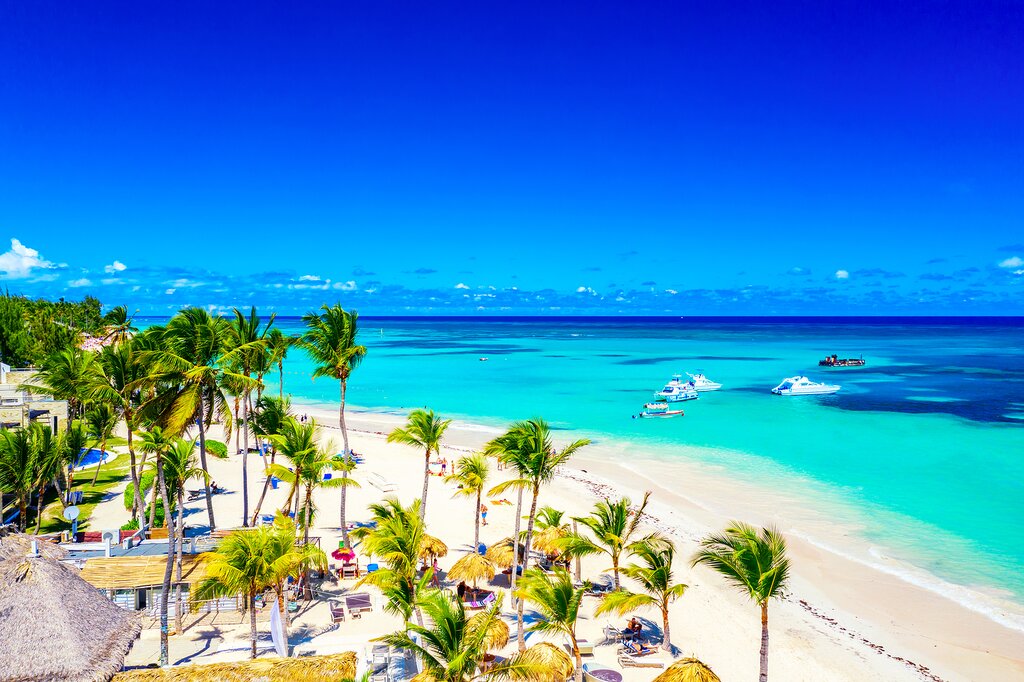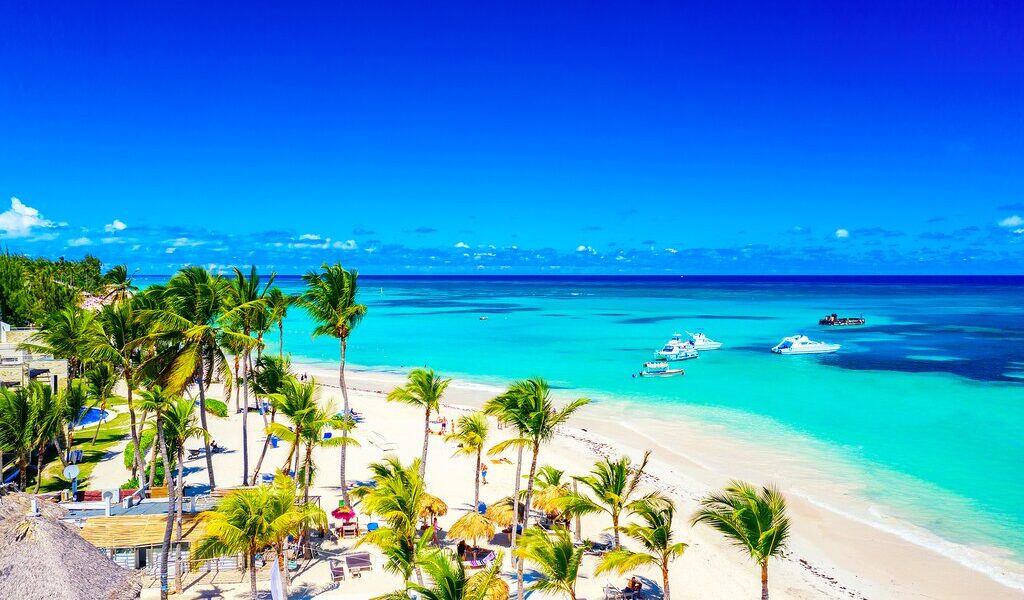
It doesn’t get much better than February in the Dominican Republic. Sure, it’s peak busy season—thanks to the dry, glorious beach weather—but there’s a peaceful window leading up to the arrival of spring breakers and Carnaval celebrations. Read on to learn more about this exciting Caribbean destination in February.
## Weather in the Dominican Republic in February
For many seeking respite from the lingering clutches of winter that grip much of the US, Canada, and Europe, the Dominican Republic (DR) presents an irresistible allure in February. The island nation’s extensive coastline, a breathtaking panorama of nature’s artistry, unfurls into seemingly endless stretches of soft, white sand. This pristine expanse is bathed in the constant, comforting warmth of the sun, a stark and welcome contrast to the chilly conditions elsewhere. The turquoise sea shimmers and sparkles, creating a visual symphony of vibrant blues that invigorate the senses and calm the mind.
February in the Dominican Republic also coincides with the dry season. While a brief, refreshing tropical rain shower might occasionally grace the landscape, visitors can generally anticipate significantly reduced humidity and moisture levels compared to the summer months. This drier climate also translates to fewer mosquitos, enhancing the overall comfort and enjoyment of outdoor activities. Furthermore, February falls safely outside the hurricane season, which typically spans from June to November, providing an added layer of security and peace of mind for travelers.
Across the island, temperatures are delightfully warm and inviting, typically reaching highs around 84°F (29°C) during the day. As the sun dips below the horizon, painting the sky in hues of orange and purple, the temperature gently cools, often settling around 68°F (20°C) in the evening. It is advisable to pack a light jacket or sweater for these cooler evenings, especially if you plan on enjoying open-air dinners under the stars. When planning your itinerary, particularly if it includes inland adventures, remember to consider the DR’s diverse topography and geology. From arid desert landscapes to lush subtropical pine and rain forests, the island presents a variety of climates within relatively short distances. Footwear appropriate for hiking and comfortable layers of clothing are essential, especially for those venturing into higher elevations where temperatures can fluctuate rapidly.
## Crowds and Costs in the Dominican Republic in February
The idyllic weather that graces the Dominican Republic in February naturally translates to peak season pricing for flights, hotels, car rentals, and excursions. While these costs are elevated compared to other times of the year, they generally remain slightly lower than the peak holiday season in December. Booking your travel arrangements well in advance is highly recommended to secure the best possible rates and ensure availability, particularly for popular accommodations and activities.
The first two weeks of February often provide a sweet spot for travelers seeking a balance between favorable weather and fewer crowds. This period offers a more tranquil atmosphere, nestled between the bustling Christmas and New Year holidays and the imminent arrival of spring break. Those prioritizing a relaxing and uncrowded vacation experience will find this timeframe particularly appealing. As the month progresses, however, the influx of younger travelers gradually increases, particularly during the United Kingdom’s half-term break, which occurs earlier than spring break in North America. February is also a popular month for vibrant cultural festivals like Carnaval, adding to the festive atmosphere and attracting lively crowds to towns and cities, especially in the days leading up to the country’s Independence Day on February 27th.
## Where to Go in the Dominican Republic
The Dominican Republic, occupying the eastern portion of the island of Hispaniola (which it shares with Haiti), is a sprawling country characterized by diverse inland terrain and nine distinct ecological zones, each offering a unique tapestry of natural beauty. Many visitors arrive and depart through the bustling international airport in **Punta Cana**, situated on the eastern coast of the island. This area boasts an extensive selection of all-inclusive resorts catering to a wide range of budgets and preferences. However, **Punta Cana** is somewhat geographically isolated from other regions of the country. Travelers primarily seeking a relaxing beach vacation with limited excursions may find this location ideal.
For those with a desire to explore a broader range of the Dominican Republic’s offerings, consider flying into or out of the airport in **Santo Domingo**, the nation’s capital, located along the southern coast. This provides convenient access to both the stunning Caribbean coastline and the captivating inland gems that lie further afield. A particularly noteworthy destination is the resort town of **Jarabacoa**, a gateway to the **Cordillera Central**, the island’s majestic central mountain range. Within this range lies **Pico Duarte**, the highest peak in the Caribbean, offering a variety of outdoor adventures for thrill-seekers and nature enthusiasts alike. Continuing north from **Jarabacoa** will lead you to **Puerto Plata** and the breathtaking beaches that line the Atlantic coast, renowned for their active watersports opportunities. The northern coast also serves as a popular breeding ground for majestic humpback whales during this time of year, offering a truly unforgettable wildlife experience.
## What to Do in the Dominican Republic
With an impressive 800 miles (1287 km) of coastline, finding an inviting beach fringed with swaying palm trees in the Dominican Republic is an effortless endeavor. Many all-inclusive resorts cater specifically to beachgoers, providing complimentary access to non-motorized watersports equipment such as snorkel gear, kayaks, sunfish sailboats, and small catamarans. This allows guests to fully immerse themselves in the crystal-clear waters and explore the vibrant marine life that thrives just offshore, keeping many travelers content within the confines of their chosen property.
For those seeking more adventurous aquatic experiences, numerous PADI-certified dive centers operate across the island, offering excursions to explore captivating deep-sea wrecks and vibrant coral formations teeming with marine life. The northern coast, particularly the area surrounding **Cabarete**, has earned international acclaim as a world-class destination for windsurfing and kitesurfing, thanks to the consistently strong trade winds that sweep across the waters. February also marks the peak of whale-watching season, when magnificent humpback whales migrate to the warm waters surrounding the **Samaná Peninsula** to give birth to their calves. This eco-friendly region also boasts secluded beaches, cascading waterfalls, and lush rainforests, offering a diverse range of natural wonders to explore.
Beyond the beaches and coast, the Dominican Republic’s interior provides a wealth of opportunities for hiking, bird watching, and river rafting, particularly within the country’s 29 protected national parks. The DR is home to four of the five highest peaks in the Caribbean, providing options for both invigorating day hikes and challenging multi-day treks that reward adventurers with breathtaking panoramic views.
If your travel plans include flying into or out of **Santo Domingo**, be sure to dedicate ample time to explore the oldest European settlement in the Western Hemisphere. The capital city is a treasure trove of historical landmarks, including ancient forts, fascinating museums, and stunning examples of colonial architecture dating back to the 1500s. Furthermore, February is synonymous with Carnaval season, a time when cities and towns across the Dominican Republic come alive with vibrant parades, infectious music, and spirited dancing in the streets.
## Events in the Dominican Republic in February
* **Master of the Ocean, near Cabarete:** This renowned watersports competition, held annually on the north shore, attracts top athletes from around the globe, showcasing their skills in surfing, windsurfing, and kitesurfing.
* **Carnaval Vegano, La Vega:** Considered the largest and most lively of the nation’s carnivals, **Carnaval Vegano** is an explosion of color, music, and tradition, featuring elaborate devil masks and the distinctive *vejigas* (rope whips).
* **Carnaval, Santo Domingo:** The capital city’s major Carnaval celebration unfolds in the days leading up to February 27th, transforming the streets into a vibrant spectacle of elaborate floats, exhilarating street dancing, and flamboyant costumes.
* **Independence Day, Santo Domingo:** On February 27th each year, the capital city comes alive with festive street celebrations and a grand military parade, commemorating the Dominican Republic’s hard-fought independence from Haiti.
B-2625

